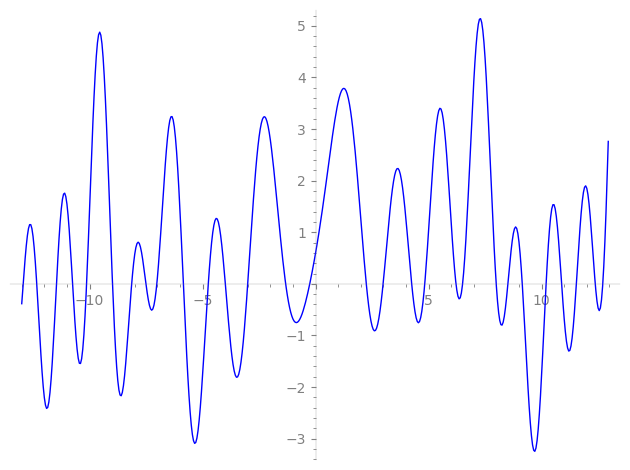| L(s) = 1 | − i·3-s + (−1.89 − 1.18i)5-s − 4.20i·7-s − 9-s − 11-s − 2.90i·13-s + (−1.18 + 1.89i)15-s − 2.41i·17-s − 6.16·19-s − 4.20·21-s + 8.05i·23-s + (2.19 + 4.49i)25-s + i·27-s + 5.68·29-s + 1.52·31-s + ⋯ |
| L(s) = 1 | − 0.577i·3-s + (−0.848 − 0.529i)5-s − 1.58i·7-s − 0.333·9-s − 0.301·11-s − 0.804i·13-s + (−0.305 + 0.489i)15-s − 0.585i·17-s − 1.41·19-s − 0.917·21-s + 1.67i·23-s + (0.438 + 0.898i)25-s + 0.192i·27-s + 1.05·29-s + 0.273·31-s + ⋯ |
Λ(s)=(=(1320s/2ΓC(s)L(s)(−0.848−0.529i)Λ(2−s)
Λ(s)=(=(1320s/2ΓC(s+1/2)L(s)(−0.848−0.529i)Λ(1−s)
| Degree: |
2 |
| Conductor: |
1320
= 23⋅3⋅5⋅11
|
| Sign: |
−0.848−0.529i
|
| Analytic conductor: |
10.5402 |
| Root analytic conductor: |
3.24657 |
| Motivic weight: |
1 |
| Rational: |
no |
| Arithmetic: |
yes |
| Character: |
χ1320(529,⋅)
|
| Primitive: |
yes
|
| Self-dual: |
no
|
| Analytic rank: |
0
|
| Selberg data: |
(2, 1320, ( :1/2), −0.848−0.529i)
|
Particular Values
| L(1) |
≈ |
0.5965183159 |
| L(21) |
≈ |
0.5965183159 |
| L(23) |
|
not available |
| L(1) |
|
not available |
L(s)=p∏Fp(p−s)−1 | p | Fp(T) |
|---|
| bad | 2 | 1 |
| 3 | 1+iT |
| 5 | 1+(1.89+1.18i)T |
| 11 | 1+T |
| good | 7 | 1+4.20iT−7T2 |
| 13 | 1+2.90iT−13T2 |
| 17 | 1+2.41iT−17T2 |
| 19 | 1+6.16T+19T2 |
| 23 | 1−8.05iT−23T2 |
| 29 | 1−5.68T+29T2 |
| 31 | 1−1.52T+31T2 |
| 37 | 1−0.577iT−37T2 |
| 41 | 1−3.30T+41T2 |
| 43 | 1+10.6iT−43T2 |
| 47 | 1+0.355iT−47T2 |
| 53 | 1−9.95iT−53T2 |
| 59 | 1+10.8T+59T2 |
| 61 | 1+8.90T+61T2 |
| 67 | 1−5.40iT−67T2 |
| 71 | 1−6.61T+71T2 |
| 73 | 1−6.21iT−73T2 |
| 79 | 1+13.4T+79T2 |
| 83 | 1+10.7iT−83T2 |
| 89 | 1+7.52T+89T2 |
| 97 | 1−3.33iT−97T2 |
| show more | |
| show less | |
L(s)=p∏ j=1∏2(1−αj,pp−s)−1
Imaginary part of the first few zeros on the critical line
−8.983816211202246066379738589154, −8.135429522343422851480260021407, −7.50432389549228349771855314591, −7.02326788442823698069241389314, −5.84864328016698904943527096700, −4.74590772350914974716326111534, −3.99227897769908756969761962892, −3.00166266735070065746905819549, −1.32260103586234665145656891242, −0.25756743806928078009709982620,
2.24427361220912339731730182142, 2.98826002543314049682404789603, 4.25283259754301588656620124051, 4.83027951515077042349212764689, 6.21302965367055574824252607822, 6.50445271082852464531645814025, 7.992723719607109670433338616025, 8.509131147322587580971286097414, 9.144457357324155084261144341266, 10.20039873826528918230133508866

